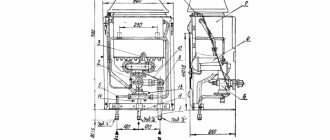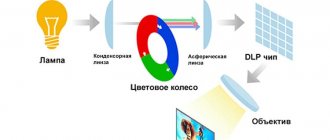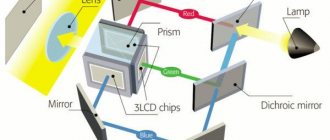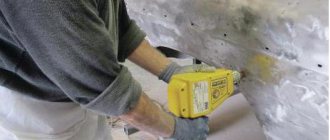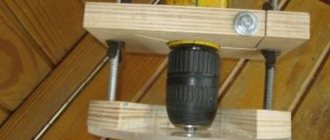Preparatory stage of repair: what is important to do before disassembling the microwave oven housing
After the safety briefing, we do the following:
- preparation of the workplace and tools;
- studying technical documentation;
- external inspection of the equipment being repaired.
The first question should not cause difficulties: I’ll omit it. But there may be problems with technical documentation. Therefore, I made a couple of simple diagrams that will allow you to understand the principles:
- operation of kinematic units;
- building electrical connections.
How does the mechanics of a microwave oven work?
High-frequency radiation is directed in one direction, but is reflected inside the cooking chamber. It creates local heating of individual areas of food. To increase the volume of the heated area, a rotating table is used, driven by its own electric motor with a drive.
The magnetron emitter is cooled by its own fan. The door curtains ensure smooth movement, and the latches clearly fix the closed position, controlled by limit switches.
What does the electrical circuit of a microwave oven consist of?
Here you need to clearly understand that a microwave oven can be controlled:
- digital technologies;
- or through the use of electromechanical devices.
Each option has different schemes with specific features. Therefore, for repairs, it is advisable to find an exact technical description from the manufacturer, which is quite difficult.
I’m showing a simple electrical diagram that allows you to understand the operating algorithms of such devices.
It includes:
- a high-frequency filter, which is designed to exclude the output of microwave pulses into household wiring and/or smooth out incoming interference;
- control module connected by microswitches with a programmer and buttons. It operates from a relay or microprocessor-based pulse shaping device;
- a high-voltage transformer with windings connected to a voltage multiplier and a cathode heating circuit;
- the magnetron itself, which produces electromagnetic waves in the microwave range.
What to look for when inspecting the stove externally
Before disassembling the case, it is necessary to evaluate:
- whether power supply is supplied to the internal circuitry;
- how reliably the door curtains and door locks work;
- Do the locking contacts switch clearly;
- smooth rotation of the table tray and the condition of its drive;
- backlight operation;
- the state of cleanliness of the waveguide window, as well as the internal walls of the cooking chamber.
When disassembling the case and removing the doors, be sure to photograph all components and mechanisms in their original and dismantled state. These pictures will greatly facilitate the subsequent assembly process.
Further, if we could not find a specific circuit from the manufacturer, we will rely on intuitive thinking and common sense.
Additional items
There are several complementary parts to a microwave. Often, a microwave oven is equipped with a grill in the form of heating arcs or infrared quartz lamps. A convector works in tandem with it. These elements are quite reliable and break down in exceptional cases.
An infrared heater is usually made in the form of two quartz lamps connected in series. With a power of 500-600 watts, they consume a current of 115 volts. Unlike the microwave heating option, the grill does this from the top layers to the inside. Although this takes more time, otherwise you won’t be able to fry the crust.
A convector is necessary for proper air circulation. This helps the food heat evenly.
Repair features
One of the most common malfunctions is due to the fact that the microwave does not respond in any way to opening the door and operating the equation panel. It happens no less often that the oven does not heat, although it shows signs of operability: the lights are on, the glass table is rotating.
If there is no response to launch
First you need to check whether current is flowing to the surge protector. To do this, the casing is removed, and the high-voltage capacitor is forcibly discharged. Check the power cord with a multimeter. All wires running from the socket to the terminals must be connected. The grounding terminal must be connected to the housing.
If the wire is intact, then you need to check the condition of the mains fuse. It can be found on the filter board. In case of malfunction, you will have to install the same one. It is important to take into account that a more serious malfunction caused the fuse to burn out - it would not be superfluous to inspect the microwave.
When performing a visual inspection, it is better to use a flashlight and a magnifying glass. The following factors indicate a problem:
- breakdowns and abnormal holes in elements;
- darkening similar to burning;
- swollen capacitors or deformation of other elements.
The sense of smell will help diagnose the problem. The smells of burnt insulation, failed printed circuit boards or transformer oil are quite strong and therefore easy to detect. If you understand where the smell is coming from, you can localize the problem.
Light without heating
Often this situation is caused by faults with the high-voltage circuit or magnetron. But before checking these components, you need to inspect the camera. You need to make sure that there are no burnt holes, dirt or worn out enamel anywhere. The rectangular plate of radiotransparent dielectric located on the left must be removed and examined especially carefully. To do this, you will have to wash it with alcohol.
If there are through holes or dark spots on the plate, it will have to be replaced. Most likely, this happened due to the fact that metal utensils were placed inside the oven or they forgot about timely cleaning.
You need to check the safety diode in the magnetron circuit. If it burns out, then just install a new one. The part must have original parameters.
A burnt-out antenna cap indicates the need to replace the magnetron. The same applies to breakdowns in the housing. If the microwave oven has been in service for more than five years, then repair may not be advisable - it is more economical to buy new equipment.
Special parts
There are special elements in the magnetron power circuit, the properties of which must be taken into account when making independent repairs. This primarily concerns the high-voltage capacitor. It has a built-in resistor necessary for the discharge. The capacitor is under voltage up to 2 kV during operation. However, after finishing work, it may not discharge. This will happen if the internal resistor has burned out. Therefore, there is an important safety measure: before starting repairs on the microwave oven, the capacitor must be forcibly discharged.
A large high-voltage diode consists of many small ones. Thanks to their series connection, the combined element can operate with high voltage. However, this excludes the possibility of testing the diode using the standard method, because the device has high resistance both when connected directly and in reverse.
For many diodes, the highest possible forward voltage is 11 volts, achieved by connecting a dozen smaller parts in series. With this combination, the maximum constant reverse voltage reaches 12 kilovolts.
Bidirectional high-voltage suppressor - a protective diode installed in parallel with the high-voltage capacitor. It is necessary for protection against overvoltage, but often fails. However, the microwave will work even without it - during repairs, the protective diode can simply be removed. If possible, it is better to replace it with a new one - this way the high-voltage capacitor will last longer.
It is better to look for a detailed diagram of a microwave oven from a specific manufacturer in the original instructions. You can find it on the manufacturer's website. The manual should contain recommendations for checking elements, a list of incoming parts, diagrams and disassembly procedures.
General operating principle of a microwave oven
The physics of the process of heating the contents of a microwave oven is quite simple. Microwave radiation affects the molecules of products, and due to their mutual friction, heat is released. But this is too simple an explanation.
In fact, only water molecules undergo vibrations. But if you put an ideally clean glass of distilled liquid in the microwave, its temperature will change quite little during the standard operating time of the oven. So why do foods heat up? This occurs due to the friction of molecules at the boundary of media, that is, different substances. And since the structure of any material, be it an edible product or a piece of wood, is large and necessarily contains water in the structure, fluctuations of different amplitudes arise.
Important! The frequency of the microwave oven is designed to have maximum effect on the molecules of the liquid. It is they, with their intense vibration and friction against neighbors, that contribute to the release of large amounts of heat. Materials that are dry and pure in chemical composition heat up very slowly, but there are few of these in nature.
Metals should not be placed in the microwave. When exposed to microwave radiation, surface currents are formed and spark and arc breakdowns occur on the walls of the internal compartment of the furnace. However, technological progress has found a way out. Today, many companies, such as Daewoo, produce microwave ovens in which metal objects can be placed. Also, many models allow the use of closed contours, in particular, plates with foil stamping on the edge or decorative dishes with a metal edge.
Safety regulations
When using and repairing any household appliances, you must follow safety rules. Violating them can not only damage the device, but also harm human health or life.
Using a microwave oven correctly is easy:
- If the door is open, the oven cannot be turned on. This may occur if the waveguide or door locking system is damaged.
- You cannot connect a removed magnetron, it is dangerous to life.
- Do not operate the oven with a broken fan, otherwise it will lead to damage to the magnetron.
- Any actions with microwave parts are permissible only after disconnecting from the network and completely forcibly discharging the high-voltage capacitor.
- When the repair is completed, all objects must be removed from the waveguide, regardless of their size.
- Do not turn on the oven without load. If you need to run it in idle mode, then you must supply some food. It can be replaced with a container of water.
When disassembling, you should take photographs of each step. If problems arise with assembly, you can use the existing photographs. It is advisable to capture the original position and fastening of all parts using mobile phones or digital cameras.

